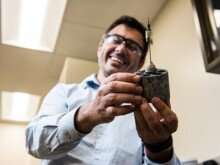Self-healing cement could transform geothermal industry

A self-healing cement developed by Pacific Northwest National Laboratory can outperform conventional concrete, offering a potentially pollution-preventing technology for the growing geothermal industry.
This game-changing combination uses a flexible ingredient, a polymer, to repair fractured surfaces and fill cracks, minimizing mechanical failure risks and offering a sustainable energy source.
Chemist Carlos Fernandez and his team in collaboration with Simerjeet Gill of Brookhaven National Laboratory, detail the polymer's healing properties and how it can improve the mechanical performance of cement in a paper, "Insights into the physical and chemical properties of a cement-polymer composite developed for geothermal wellbore applications," in Cement and Concrete Composites.
Funding for the research was provided by the Department of Energy's Geothermal Technologies Office.
Polymers under pressure
Cement used in geothermal wells is known to crack under pressure and in high-temperature environments associated with drilling for geothermal energy. The objective of the team's paper was to see how its self-healing cement would hold up when tested against conventional cement in these extreme heat conditions. Through a variety of tests, performed at PNNL and BNL's National Synchroton Light Source II, the team found that the self-healing cement technology could eliminate the need to remove, repair and replace cracked cement wells.
PNNL researchers tested their self-healing cement's strength and reactions to mechanical stress and conducted analyses of surface area, chemical composition, and surface topography. The tests confirmed that the self-healing cement is a significant alternative to conventional cement because it is flexible and autonomously heals cracks.
The flexibility is attributed to chemically "soft" or flexible bonding between the atoms in the polymer and cement. This soft bonding allows large deformations that can be contained within the cement without breaking the bonds. This was predicted through computational modeling done by PNNL's Vanda Glezakou. The polymer adds 60 to 70 percent more elasticity to the cement when it is added, reducing fractures in the cement, Fernandez reports in the paper.
On their own, polymers are large, chain-like molecules that work to hold substances together and are naturally found in the human body. When added to cement, polymers add flexibility to brittle material and keep cracks from spreading quickly. The polymer detaches, migrates to the crack, and attaches back to fill the crack. There was an 87 percent reduction in crack size when the polymer was added to the concrete.
Cementing the future
Cement is the second largest consumable in the world behind water. Thus, finding a way to make cement even more effective could be a game changer not only for the geothermal industry but the construction industry overall.
"The idea in a few years would be to extend it to everything," Fernandez said. "The sky's the limit."
The cement industry earns more than $37 billion annually. However, cracking cement averages $12 billion a year to repair infrastructure alone. The polymer-cement combination could amount to $3.4 billion a year in savings for infrastructures like dams, nuclear waste facilities, and skyscrapers, Fernandez predicts. This could mean fewer road closures and maintenance repairs that clog roads and create inconveniences for daily commutes.
Like an LED light fixture, the polymer-cement could create long-term savings. Conventional cement is 5 cents per pound. The estimated cost for the polymer-cement is 30 to 35 cents per pound. However, it could potentially extend the life of concrete-based structures by 30 to 50 years, Fernandez said.
For the oil industry, specifically, where high temperatures are a constant, removing and replacing cracked concrete is a time consuming, costly venture, Fernandez said. Replacing conventional cement with self-healing cement can amount to millions of dollars in savings.
The self-healing cement also could be used at nuclear waste facilities and hydropower dams where cracks in the structures and mechanical failure could result in flooding or contamination. Costly annual and biannual inspections and repairs could decrease in number, Fernandez said. The flexible nature of the self-healing cement also allows it to withstand greater mechanical stress from natural disasters and extreme weather conditions such as earthquake tremors or high winds.
A concrete alternative for the environment
Self-healing cement could resolve major concerns about the sealing of wellbores for oil, gas, and geothermal heat production. Leaks in wellbores cause contamination and limit the ability to provide clean energy alternatives. These leaks contaminate aquifers and surface waters.
Other self-healing polymer-cement blends developed for the oil and gas industry often have poor mechanical properties and cannot withstand the high-temperature environments found in geothermal wells.
"The development of a self-healing polymer-cement combination which is functional in geothermal environments could represent a game-changing technology towards the growth of the geothermal energy industry," the team reported in the paper.
There are large geothermal energy reserves across the country and around the world that are not in use because wellbore cement fails in high-temperature conditions and in chemically corrosive environments. Geothermal energy is thermal energy that the Earth generates and stores. With improvements like self-healing cement, geothermal energy has the potential to be an applicable, sustainable energy source. The self-healing cement can deliver significant energy with minimal carbon release to the atmosphere.
Additionally, tens of thousands of tons of conventional cement ends up in landfills, Fernandez said. With the extension of more than 30 years of additional usage of the composite, less cement would go to landfills.
More information: Kenton A. Rod et al. Insights into the physical and chemical properties of a cement-polymer composite developed for geothermal wellbore applications, Cement and Concrete Composites (2018). DOI: 10.1016/j.cemconcomp.2018.12.022
Provided by Environmental Molecular Sciences Laboratory




















